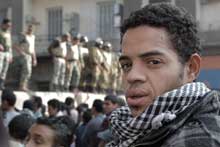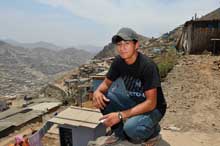Voices of Youth
Finance & Development, March 2012, Vol. 49, No. 1
PDF version
![]() IMF video:
Global youth, leaders of change
IMF video:
Global youth, leaders of change

As the global youth population reaches a historic high, we are witnessing a generation adrift. For many people coming of age, the dream of learning a profession or trade and finding secure employment is out of reach. It’s not as if today’s youth somehow went astray. They have played by the rules, following the formula that was supposed to bring economic independence and a happy life. They’ve gone to school to become productive members of society, but there aren’t enough jobs, or the skills they’ve acquired don’t correspond to the jobs available. Some are willing to leave for the big city, or go abroad, in search of a better life. But the dream proves elusive.
From Cairo’s Tahrir Square to Madrid’s Puerta del Sol, youth everywhere have protested the lack of economic opportunity. Clearly the system is cracked—but no one knows quite how to fix it. Here are the stories of six youth, told in their own voices.
A Revolutionary in Egypt

AHMAD Hasan is a revolutionary at heart. But the 25-year-old Egyptian never imagined that his country would one day rise up in revolution as it did on January 25, 2011. He never dreamed that he would become one of the key people responsible for providing security in Tahrir Square throughout the initial days of the revolution, a turn of events that has restored his self-confidence.
“Definitely, I was a different person before the revolution. After the revolution, I became capable of criticizing any official and demanding a change of anything I do not like in the country. I will always draw strength from the liberation, and I will continue going to the square until the aspirations of the people are realized,” Hasan says.
Hasan is a middle child. His older sister has married, easing the family’s economic burden, and his younger brother will graduate soon from a business school in Cairo. His father died when he was only six, leaving Hasan’s mother as the family’s sole support. She leases a small store where she sells vegetables in Shubra al-Kheimah, one of Cairo’s oldest, poorest quarters.
He began working as a child, a year after his father’s death. His mother sent him to the market daily to sell a basket of lemons. He would give her most of the proceeds and keep a small portion for himself, which he used to buy school supplies and clothes.
“I was not born to choose anything in life. I have always been a prisoner of my circumstances and fate,” Hasan muses.
He earned good enough grades to be admitted to the College of Education. Unable to afford the tuition, however, he settled for admission to a two-year journalism program in a post-intermediate college.
With youth unemployment at more than 25 percent, satisfaction in life is something millions of young Egyptians are sorely lacking. According to the Population Council’s 2009 survey of Egyptian youth, 30 percent of males ages 15 to 29 said they were looking to migrate, mostly to an oil-rich Gulf state, because they did not expect to find work at home. Hasan would likely have chosen this course had it not been for the events of January 25.
The youth unemployment problem stems partly from a serious mismatch between the skills young people possess and those that firms seek. Employers frequently cite the lack of suitable skills among job seekers as a constraint to hiring. And unemployment rates are actually highest among the most educated, which suggests that education systems are failing to produce graduates with marketable skills.
“I was desperate. Some days before the revolution, I was fired from my job because I got into a debate with my manager, who was a supporter of Gamal Mubarak’s assuming the post of president after his father,” says Hasan, who at the time was working as a sales representative for a wireless phone company.
“I remained without work for 24 days. I considered traveling abroad until I heard that young people were intending to hold demonstrations on January 25,” he recalls. “On January 24, I went out to check out the squares and streets, eager for a chance to vent my anger. The next day, I was in the square at 7:00 a.m. and remained there until the president stepped down.”
Now a part-time videographer with a documentary television production company, Hasan dreams of finding a steady job in his field and being treated with respect and dignity by the police. “The most important reasons behind the revolution were lost dignity, poverty, corruption, rigged elections, and the spread of nepotism and cronyism,” says Hasan.
For now, though, Hasan will keep working toward change, one day at a time. ■
Reporting: Hisham Allam; photography: Maggie Osama
Chasing a Goal in Bosnia

IRMA Boracic has set bold career goals for herself, chased by a desire to become a judge at Bosnia and Herzegovina’s top criminal court. But two years after graduating from the Sarajevo University Law School, the 24-year-old is still searching for a job, pursuing further training while rejections to her job applications keep piling up.
Many European countries suffer from high unemployment rates, but Bosnia’s problem is chronic, with 75 percent of all the unemployed out of work for more than two years and 50 percent for more than five years, according to the Bosnian Statistics Agency.
“I have submitted over 300 job applications in the past two years,” says Boracic. “I was short-listed many times but somehow I have never been offered a job.” Bosnia’s unemployment rate is also one of the highest in Europe. Those under 25 are affected the most, with close to 50 percent in this age group out of work.
Boracic was born in the Bosnian capital of Sarajevo, where she finished elementary and high school and got her university degree. She is single and lives in a family apartment with her mother and sister, who are supporting her financially while she studies for a final judicial exam.
“Since I joined law school, I have been dreaming about becoming a criminal judge. I think that I am qualified enough to work on the gravest crime cases,” Boracic says passionately.
Even though she has set her goals high, Boracic says that any job in the legal field would suffice to get her started in her career, whether in the private or public sector. Boracic completed a two-year unpaid internship at a Sarajevo court, first as a volunteer and later receiving only meals and a transportation allowance. Since completing the internship, she has been unable to land a job despite her active search.
In Boracic’s opinion, the education system does a poor job of aligning skills acquired by students with those required by the labor market. She thinks there are too many lawyers and economists. An IMF study supports her view: the sizable skills gap is one of the main constraints on the development of the country’s labor market. About two-thirds of secondary school students are enrolled in technical or vocational schools with narrowly specialized and sometimes outdated programs. Students leave the system without important skills in communication, problem solving, and teamwork, which are in high demand in the labor market.
A part of the former Yugoslavia, Bosnia and Herzegovina went through a traumatic transformation in the 1990s. The 1992–95 war caused immense human suffering, destruction of infrastructure, and an almost 80 percent decline in GDP. The 1995 Dayton Peace Agreement, which ended the war, created a complex political system that is frequently bogged down by ethnically motivated policies. “It is a very difficult situation,” Boracic says. “For young people like me, who are ambitious and have invested a lot in themselves, the chances of succeeding in the labor market are slim. It is very hard to find jobs in a country where the economy is not strong enough and where the state institutions are weak.”
Boracic also speaks of the corruption that affects aspects of life in her country, including employment. “At the moment, most people are getting jobs based on family ties and connections rather than on merit. In many cases, young people are asked to pay bribes in order to get hired,” she says.
Boracic expects to pass the judicial exam in March and will continue her job search, hoping that her efforts will eventually bear fruit. ■
Reporting: Daria Sito-Sucic; photography: Dado Ruvic
Postponed Ambitions in Peru

IN a shantytown on the outskirts of Lima, on a barren hillside, men and women wait while a bright-blue tanker truck fills plastic barrels with water, which they must haul up long staircases under the broiling sun.
The decade-long boom that saw Peru’s economy grow on average at 5.5 percent between 2000 and 2010 has significantly reduced poverty but it does not seem to have crept uphill to Flor de Amancaes, a cluster of brightly painted but flimsy wooden houses perched precariously on the rocky slope.
“For some people, I suppose things are better, but I don’t see it here,” says Adilmer García, 19, glancing up the hill at the one- and two-room dwellings.
Despite recent improvements, income inequality in Peru remains stubbornly high.
García was just 15 when he traded life on his family’s tiny farm in the mountains of Piura, in northern Peru, for what he saw as a brighter future in Lima’s sprawling capital. Four years later, home is a tiny prefabricated house at the very edge of the city, beyond the reach of the electrical grid and the municipal water supply.
“I came to work and to study,” he says. “I saw a better chance to find a job, but especially for education.” City life hasn’t worked out the way García had hoped. When he arrived, he moved in with his brother, and he landed his first job two months later. But working full time six days a week left García with no time for classes, and he still hasn’t been able to go back to school.
Most recently, he worked in a glass cutter’s shop in a middle-class neighborhood an hour from his home, earning about $75 for a 60-hour week, with no insurance or other benefits. But that job ended in late 2011, and he is hunting again.
This time he wants to find a job that will leave the morning or afternoon free for classes, but he is doubtful about his prospects. “There’s work, but it’s harder to find a job that will also let you study,” he says.
He isn’t sure what kind of trade or career he might pursue. “I want to finish high school,” he says, “then see what I like best.” Despite his postponed ambitions, García does not regret moving to the city.
“The good thing here is that if you work, you earn money,” he says. “On the farm, you work, but you don’t have money.” García is not alone. Over the past two decades, some 130,000 people a year have moved to Lima, which is now home to 7.6 million people.
Originally built on Peru’s coastal plain, the city has crept up the rocky Andean foothills to the east, with each new wave of settlers claiming land once considered useless, farther up the steep, arid slopes. Their lives gradually improve, but in increments far smaller than the upward curve of the country’s GDP.
“Four years ago, there weren’t staircases” up the treacherous hillside, García says of Flor de Amancaes. “There wasn’t a road. There was just a narrow path, and cars couldn’t get up here. The houses were smaller—they’ve been remodeled. In the years I’ve been here, I’ve seen progress. I hope it continues.” But his dream still hovers beyond his grasp.
“Sometime in the future, if we get electricity and water, this would be a good place to live,” he says. “I’d like to have a house of my own, but that’s in the future. Right now, I want to work and study.” ■
Reporting: Barbara Fraser; photography: Oscar Medrano Pérez
Call to Action in the United States

WHEN the collapse of U.S. investment bank Lehman Brothers in September 2008 set off global economic turmoil, Alexa Clay did not feel the despair many felt. For Clay, who had just turned in her master’s thesis in economic history at Oxford University, it was a call to action.
“I don’t think of myself as a protester,” said Clay, although she is a member of the Occupy Wall Street protest movement that is giving a voice to youth and others against economic and social inequality in the global economy. “It’s not about being reactionary, but actually reimagining what capitalism looks like today. . . . My mission is to empower people to feel like they can make a change in the economy, not be paralyzed by it.”
Clay says a defining characteristic for young people today is entrepreneurship as well as a sense of identity drawn from their vocation.
“You know yourself by the change you’re trying to create; I think that’s true for many of my generation.”
Clay does not consider herself a victim of the global economic crisis. Now 27, she worked through graduate school, lives in Washington D.C., and has enjoyed steady employment since Lehman failed—a period in which the U.S. unemployment rate rose from 6.5 percent to peak at 10 percent in October 2009 then slowly subsided to about 8.5 percent in early 2012.
The self-described nomad now works for a Washington-based non-profit group whose mission is to bring about social change through entrepreneurship. She recently travelled to Kenya and Rwanda to research youth unemployment and job creation and soon will go to India to begin research on the informal economy.
Clay may have worked steadily during the crisis but she knows all too well that young people are struggling to find jobs. “We’re going to have to be much more creative and scrappy to create opportunities and jobs for ourselves; they won’t be hand delivered to us.”
She thinks the Occupy movement and its worldwide protests have created a space for citizens to express their massive frustration with the current economic system. But she criticizes the movement for not having “enough of a theory of change I can buy into.”
Economics has become disconnected from the real issues that matter, says Clay: how do we distribute resources fairly in society and what are the conditions for a prosperous economy?
“Economic theory tends to be self-referential and closed to most people,” says Clay. She wants members of the profession to communicate their thinking in a more democratic language because “our economic system has become so much more complex, and for most people it’s really difficult to engage in economic discussion.”
Clay says the doctrines of self-regulating markets and individuals acting in their self interest didn’t hold up during the crisis and economists are now beginning to reimagine their profession and their role in society.
While the Occupy Wall Street protests created a way to express a massive frustration with the current way of doing things, Clay wants more dialogue, including with those in power, about how to take a different approach.
“The biggest challenge for Occupy Wall Street is how to make citizens become real change agents in shaping our future economy; not just passive resisters of the crisis.” ■
Reporting: Jacqueline Deslauriers; photography: Stephen Jaffe
Lost and Alone in Japan

TAKUMI Sato survives on a single pot of instant noodles a day and says if he were not receiving a disability check from the Japanese government he would be homeless.
“I studied computer game design and production at technical college and got a job as an assistant director for a company that made animated television and video programs,” said 23-year-old Sato, who lives by himself in a one-room apartment in Kawagoe, just north of Tokyo.
“But it was not really a full-time job, and even though I was working eight hours a day, I didn’t have a contract,” he said.
It is the situation of more and more Japanese workers as companies—feeling the pinch of the past few years’ economic slowdown—abandon the nation’s vaunted system of lifetime employment and the carefully nurtured sense of the company as a family. Instead, workers are hired under short-term rolling contracts that allow employers to cast them adrift with little warning and no support.
Against the backdrop of Japan’s weakening economy, the social safety net is also deteriorating, with just 23 percent of unemployed people eligible for benefits. The fragility of the labor market combined with the lack of support services is taking its toll on the health of the population. Some have even taken their own lives.
Sato lasted two months in his next job, preparing bento box meals for supermarkets and convenience stores, earning Y130,000 ($1,671) a month for an eight-hour day, five days a week.
Sato left after his doctor told him that he needed to stop work to prevent his mental health from deteriorating.
That was three years ago; he has since survived on Y110,000 ($1,413) from the government each month, of which Y35,000 ($450) goes for rent.
Sato is angry that while the government is doing all it can to help companies ride out the global economic storm, people like him are effectively ignored.
“They do not do enough for us, and they don’t even care when companies treat their staff badly,” he said. “They just look the other way.”
They also recognize that it is cheaper to hire foreign staff—the bento company Sato worked for brought in more Brazilian and Indian staff—who work for less and do not complain about the conditions, “as they know that they could very easily fall afoul of the immigration rules,” Sato says.
There are an estimated 11 million people earning less than Y2 million ($25,706) a year in Japan, most of whom cannot afford to rent a home, according to the Japanese nonprofit Moyai, which works with the homeless. The majority of these homeless people are in their 20s, research shows.
At its extreme, the employment situation has led to adolescents and young adults withdrawing from society, often seeking refuge in extreme isolation and confinement. Many refuse to leave their homes for months, sometimes years at a time. The condition even has its own name: hikikomori, literally “pulling inward” or “being confined.”
“The government tells people like me that I can do anything I want if I just try a little harder, if I keep on working, but it’s not true,” Sato says. “I feel as if I’m slipping out of this society, and I don’t think that I will ever be able to get back into it again.” ■
Reporting: Julian Ryall; photography: Alfie Goodrich
Mismatched Skills in Nigeria

LIKE tens of thousands of university graduates her age, Chioma Nwasonye couldn’t find a job when she left college. She completed one year of compulsory national service after graduation two years ago and has been job hunting ever since.
One of five children, 23-year-old Nwasonye graduated in 2010 with a degree in Geography and Regional Planning from Delta State University. The course “was not my original choice,” she says. “I would have loved to study accounting or business studies.”
Because her grades weren’t high enough to get her into the university’s accounting program, she entered a one-year pre-degree program that guaranteed her a university slot at its conclusion. But the pre-degree program “did not offer accounting that year so I took Geography,” she says. It still pains her that accounting was offered the following year.
About a million candidates take Nigeria’s centralized University Matriculation Examination to vie for slightly over 100,000 spots available each year at the country’s 95 public and private universities. So most young people jump at the offer of any course, as Nwasonye did, just to have access to a university degree.
Nigeria churns out thousands of graduates a year, but many cannot find work because of a mismatch between skills and market requirements, declining standards due to poor funding, and a lack of well-qualified lecturers. Some employers complain that many graduates do not have core technical knowledge in their discipline.
Nigeria’s unemployment rate is on the rise and is now close to 24 percent in Africa’s most populous country. Being highly educated does not increase the chance of finding a job. Three out of ten graduates cannot find work.
Nwasonye started with an advantage. Her mother is a primary school teacher—no mean feat given that she was raised in Nigeria’s northern region of Sapele, where 43 percent of primary-school-age girls still do not have access to basic education,according to the Northern Education Initiative, a project in the area funded by the United States Agency for International Development.
Things are better in southern Nigeria, where Nwasonye grew up, but even there the literacy rate for females ages 15 to 24 is only 65 percent, compared with 78 percent for males in the same age group, according to United Nations Children’s Fund statistics.
While she loves working with numbers, “my parents, especially my mother, really wanted me to study medicine. “Some courses in Nigeria are more respected,” explains Nwasonye. Everybody wants to be a doctor or an accountant.” Why is that? “I think it’s the economy; many people think when you study such courses you have more job offers after graduation.”
So for now she has decided to make her father—who works for the state-owned electricity company—happy by pursuing a master’s degree.
“My father has always made it clear to us that we must all go to universities and not polytechnics or colleges of education,” she says. “In fact, he mandated us to obtain our master’s degree before he will reckon with us as graduates.”
In a country with 40 million unemployed youths—many of them unemployable because of deficiencies that go back to primary school—most will not have the luxury of choosing further education to avoid unemployment. ■
Reporting: Wale Fatade and Tolu Ogunlesi; photography: Yinka Olugbade


